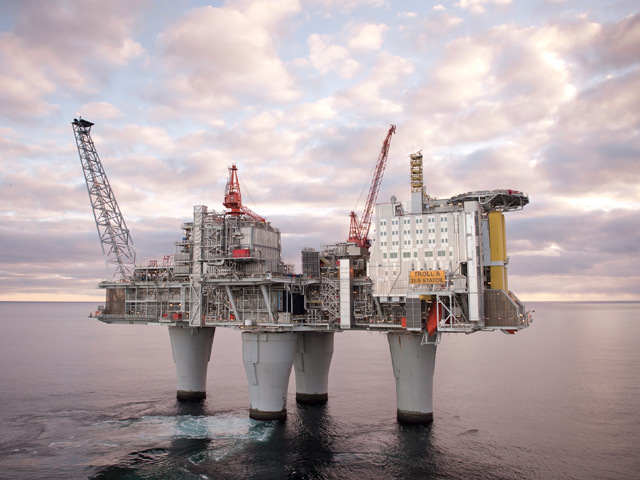
The Troll A platform rocks like a boat as North Sea waves pound its four gigantic concrete legs, but monitors inside the control room show a steady flow of natural gas continues unabated — enough to meet the needs of 10 million homes in Europe.
Norway is on track for record gas production this year after Statoil ASA put an end to technical issues that limited Troll’s capacity. And deep within the windswept jumble of pipes and machinery that top the platform 65 kilometers (40 miles) off the Nordic nation’s coast, two newly installed compressors stand ready to maintain the field’s unequaled capacity well into the next decade.
“These compressors provide an extra muscle, they strengthen the Norwegian gas machine,” Grete Haaland, senior vice president for asset management at Statoil’s marketing, midstream and processing business unit, said in a presentation on the Troll platform Wednesday. “They increase Troll’s ability to deliver more gas in the short and long term. That’s extremely important for us.”
Statoil is investing in its biggest gas field as the opportunity, but also the competition, expands in Europe. Demand in the region is growing for the first time in years, while safety concerns constrain output at its biggest onshore gas field. At the same time, prices are under pressure as Russia boosts shipments and increasing numbers of liquefied natural gas cargoes arrive from the Middle East and Africa.
Statoil’s Troll gas field is a monster by any definition. It’s Norway’s biggest field, accounting for almost a third of gas production and 48 percent of remaining reserves, underpinning its position as Europe’s biggest supplier after Russia. Its platform — the tallest structure to have ever been moved by human beings — can deliver 120 million cubic meters of gas each day. Compressor breakdowns that reduced production have been resolved, Statoil said, helping the country to increase output again.
“Norwegian gas exports will most likely reach a new record this calendar year,” said Kjell Larsen, a spokesman for Gassco AS, the operator of Norway’s offshore pipeline network.
The nation has pumped 84.6 billion cubic meters of gas so far this year, exceeding forecasts by about 12 percent, according to figures from the Norwegian Petroleum Directorate. Even if production fell back in line with NPD forecasts for the fourth quarter, total output this year would reach 116.5 billion cubic meters, beating the 2012 record of 114.7 billion.
The unexpected growth is the result of improved reliability offshore, notably on Troll, whose compressor problems affected gas production in 2013 and 2014.
“This is a closed chapter,” Troll field director Oeivind Stamnes said in an interview. “We will prevent this from happening again.” Troll will produce about 33 billion cubic meters of gas this year, Stamnes said. That’s 14 percent more than last year, according to NPD figures.
“Troll had a couple of tough years, but they have now resolved problems with compressors,” said Trevor Sikorski, head of natural gas, coal and carbon at Energy Aspects Ltd. Norway will produce 116 billion to 117 billion cubic meters of gas this year, about 9 percent more than the NPD’s forecast at the beginning of the year, the consultant estimates.
Norway’s gas exports to Europe through pipelines jumped 9 percent to a record 107.4 billion cubic meters in the 12 months through Sept. 30, according to Gassco. The Nordic nation and its Russian competitor are increasing shipments into an expanding market this year as demand growth accelerates and the region’s own output falls.
Gas consumption in industrialized nations in Europe is expected to start a recovery this year and rise on average 1.5 percent annually through 2020, driven by the power industry, according to the International Energy Agency. That would end four consecutive years of decline through 2014, data from lobby group Eurogas show.
At the same time, production at the Groningen field in the Netherlands has been capped to prevent earth tremors, creating a 12.5 billion-cubic-meter supply shortfall over the year, said Thierry Bros, an analyst at Societe Generale SA.
There is no guarantee the market for Norway’s gas will expand. Europe has more LNG arriving by ship from places such as Qatar and strong Russian flows, Sikorski said. That combination is reducing prices and in the coming of years “it will be interesting to see how Russian and Norwegian gas flows respond,” he said.
Troll’s new compressors are a bet that Europe will continue to buy Norwegian gas. The machines aren’t intended to boost Troll’s current capacity, which is about 130 million cubic meters a day including gas from the B and C platforms, Stamnes said. Rather, they will ensure Troll A retains its capacity until the middle of the 2020s, allowing an extra 83 billion cubic meters of reserves to be extracted from the field.
Norway already exports more gas than oil, according to the NPD. The nation’s gas reserves of 1,922 billion cubic meters are equivalent to 1.9 billion cubic meters of oil, more than double its remaining oil reserves of 786 million cubic meters.
“We will have a petroleum and energy minister in Norway for another 50 years,” the current holder of the position, Tord Lien, said at a seminar last week in Oslo. “That person’s title may well be gas minister.”
Recommended for you
